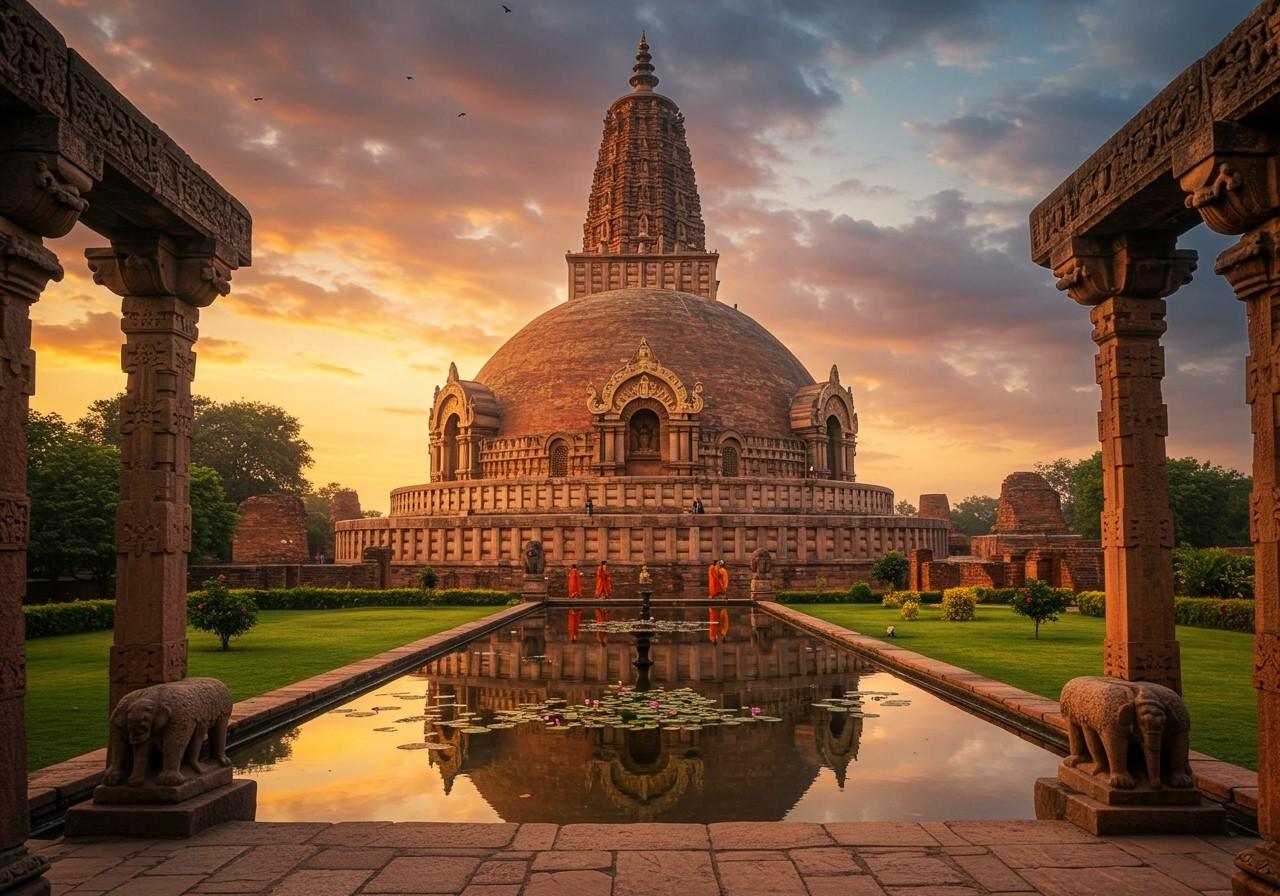
Sarnath, near Varanasi, Uttar Pradesh, is a pivotal Buddhist pilgrimage destination. Renowned for its ancient architectural wonders, it encompasses stupas, pillars, and other historical monuments. It was here that Buddha delivered his first sermon after achieving enlightenment, imbuing the site with profound historical and spiritual significance. This guide delves into the architectural marvels of Sarnath, providing insights into these captivating structures.
Sarnath Stupa
The stupas in Sarnath are monumental structures, imbued with immense historical and religious meaning. The Dhamek Stupa stands out as the most prominent, constructed in 500 CE to mark Buddha’s first sermon. It rises to a height of 43.6 meters and boasts a diameter of 28 meters, adorned with intricate carvings and inscriptions.
- Construction and Style: The Dhamek Stupa is constructed of bricks and stone, showcasing time-honored architectural techniques. Its cylindrical shape and intricate carvings are characteristic of Buddhist architecture.
- Ashokan Stupa: Originally commissioned by Emperor Ashoka and later expanded, it symbolizes a burial mound for relics. The stupa’s structure evolved over time, reflecting the enduring legacy of Buddhist practices.
- Symbolism: Stupas embody essential facets of Buddhism and play a central role in rituals. They represent the Buddha’s enlightenment and the path to liberation.
- Restoration Efforts: Ongoing endeavors focus on restoring and preserving these stupas for future generations. These efforts ensure that these historical structures remain intact.
- Landscape: The serene surroundings enhance the spiritual ambiance of Sarnath. The tranquil environment invites contemplation and reflection.
Sarnath Pillar
The Sarnath Pillar, also known as the Ashoka Pillar, is a remarkable architectural wonder. It features an edict by Emperor Ashoka championing Buddhism.
- Physical Attributes: The pillar stands tall, adorned with intricate carvings, and constructed from durable materials. Its imposing presence reflects the importance of Ashoka’s message.
- Historical Context: Erected in 250 BCE, it embodies peace and dharma, core principles of Buddhism. The pillar stands as a testament to Ashoka’s commitment to these values.
- Lion Capital: The pillar is crowned by the iconic Lion Capital, now India’s national emblem. The four lions symbolize strength, courage, and national pride.
- Preservation: Continuous efforts are underway to maintain the pillar’s structural integrity and preserve its historical significance. Regular maintenance ensures its longevity.
- Cultural Impact: The pillar has a profound impact on visitors and locals alike, inspiring awe and reverence. Its symbolism resonates with people of diverse backgrounds.
- Inscriptions: The inscriptions on the pillar offer valuable insights into ancient Buddhist teachings and Ashoka’s reign. They serve as a window into the past.
Sarnath Lion Capital
The Lion Capital of Ashoka is an iconic symbol in ancient Indian architecture. It originally graced the top of the Ashoka Pillar at Sarnath.
- Physical Characteristics: The capital depicts four lions standing back to back, exuding strength and unity. Their majestic presence is a testament to Mauryan artistry.
- Symbolism: The lions represent power, courage, and confidence, qualities valued in Buddhist teachings. They also symbolize Ashoka’s imperial authority.
- Elements: The capital incorporates the Dharma Chakra (Wheel of Law) and a lotus base, important Buddhist symbols. The wheel represents the Buddha’s teachings, and the lotus symbolizes purity.
- Artistic Excellence: The capital showcases the exceptional craftsmanship of the Mauryan period. Its intricate details reflect the skill of ancient artisans.
- Modern Iconography: The Lion Capital has influenced modern Indian symbols and serves as the national emblem. Its image appears on official documents and currency.
- Preservation: The Lion Capital is housed in the Sarnath Archaeological Museum to ensure its protection and preservation for future generations. This allows visitors to view it up close.
Sarnath: A Visitor’s Guide
Planning a trip to Sarnath? Here’s a guide to make your visit memorable:
- Key Landmarks: Explore the Dhamek Stupa, Chaukhandi Stupa, Ashoka Pillar, Sarnath Museum, Mahabodhi Society Temple, and the Thai Temple. Each site offers unique insights into Sarnath’s history and significance.
- Accommodation and Dining: Sarnath has different hotels and guest houses to fit various budgets. There are also local restaurants serving Indian and international cuisine.
- Guided Tours: Consider a guided tour to deepen your understanding of Sarnath’s historical and spiritual significance. Local guides can provide valuable insights.
- Accessibility: Sarnath is easily accessible by road from Varanasi. The nearest airport is Lal Bahadur Shastri International Airport (VNS) in Varanasi.
Enhance Your Spiritual Journey with Poojn.in
Deepen your connection with Sarnath’s spiritual heritage through authentic puja items and sacred art from Poojn.in. We offer a curated selection of products that resonate with the Buddhist and Hindu traditions of Sarnath:
- Buddha Statues and Idols: Find exquisitely crafted Buddha statues perfect for your home altar or meditation space. These pieces serve as a reminder of Sarnath’s Buddhist legacy.
- Traditional Puja Items: Discover a wide range of puja essentials, including incense, diyas, and offerings, to enhance your spiritual practice. All products are verified for authenticity and quality.
Visit www.poojn.in to explore our complete collection. We provide secure packaging, reliable delivery, and expert guidance to assist you in your spiritual journey.


